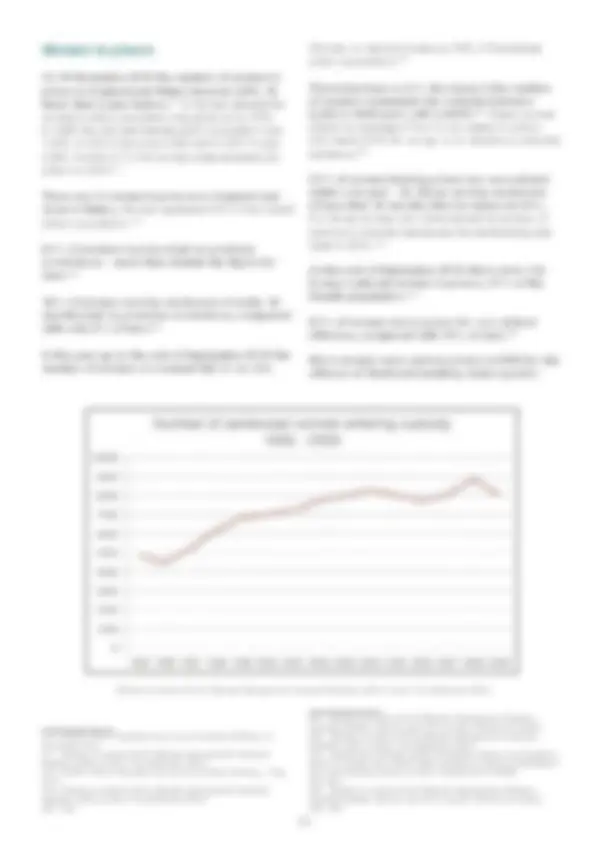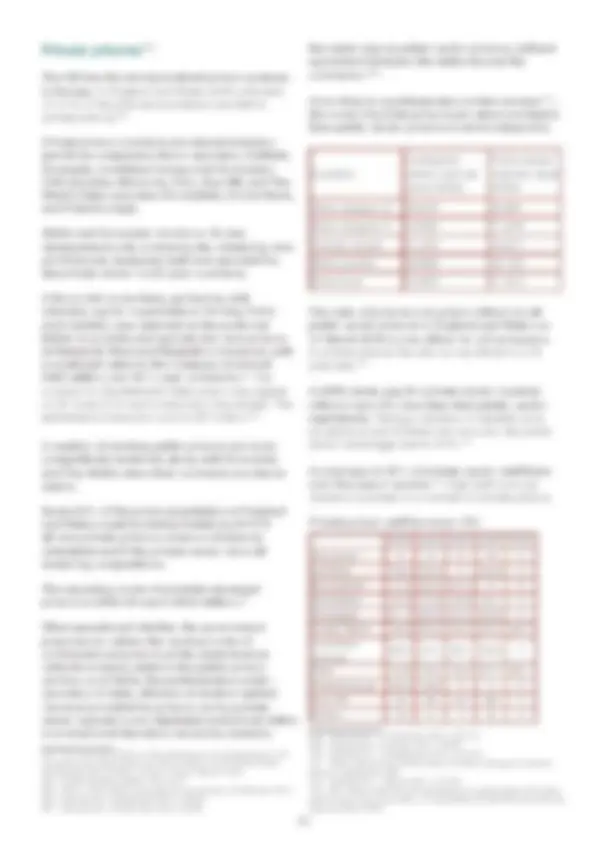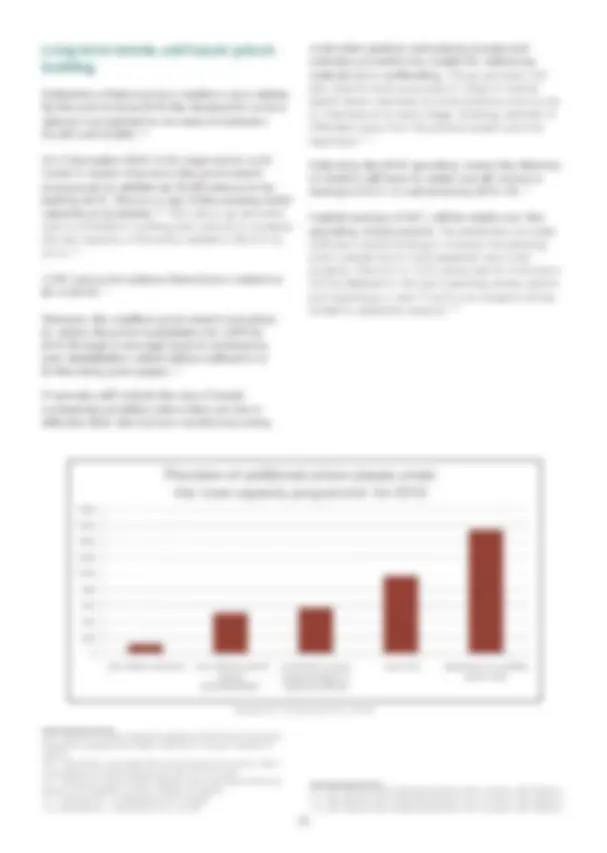


























































Study with the several resources on Docsity

Earn points by helping other students or get them with a premium plan


Prepare for your exams
Study with the several resources on Docsity

Earn points to download
Earn points by helping other students or get them with a premium plan
Community
Ask the community for help and clear up your study doubts
Discover the best universities in your country according to Docsity users
Free resources
Download our free guides on studying techniques, anxiety management strategies, and thesis advice from Docsity tutors
An analysis of the increase in prison population between 1995 and 2005, focusing on those sentenced to immediate custody and those recalled to prison. It also discusses the costs associated with imprisonment, including the cost per prison place, the cost of the crown court process, and the economic cost of reoffending. The document also touches upon the impact of imprisoning mothers for non-violent offenses and the needs of vulnerable prisoners.
Typology: Study notes
1 / 64

This page cannot be seen from the preview
Don't miss anything!

























































Cover photo: Andrew Aitchison
On 19 November 2010, the prison population in England and Wales was 85,393.^1 When Ken Clarke was last home secretary from 1992-93, the average prison population was 44,628.^2 In France, with the same population, the figure is 59,655 and in Germany with over 20 million more people, 72,043.^3 England and Wales has an imprisonment rate of 154 per 100,000 of the population. France has an imprisonment rate of 96 per 100,000 and Germany has a rate of 88 per 100,000.^4 With no change in criminal justice policy, by the end of June 2016 the prison population is projected to increase to between 83,100 and 93,600.^5 However, the government plans to reduce the prison population by 3,000 by 2014 through a new approach to sentencing and rehabilitation which will be outlined in a forthcoming green paper.^6 Proposals will include the use of tough community penalties where they are more effective than short prison sentences; using restorative justice; and paying private and voluntary providers by results for delivering reductions in reoffending. The government will also take forward proposals to invest in mental health liaison services at police stations and courts to intervene at an early stage, diverting mentally ill offenders away from the justice system and into treatment.^7 Trends and outcomes Between 1995 and 2009, the prison population in England and Wales grew by 32,500 or 66%. Almost all of this increase took place within those sentenced to immediate custody (78% of the increase) and those recalled to prison for breaking the conditions of their release (16%).^8 Approximately 70% of the increase in demand for prison places between 1995 and 2005 is 1 NOMS, Prison Population and Accommodation Briefing for 19 November 2010 2 HMPS (1993) Prison Service Annual Report April 1992-1993, London: HMSO 3 International Centre for Prison Studies, http://www.kcl.ac.uk/ schools/law/research/icps 4 Ibid. 5 Ministry of Justice Statistical Bulletin (2010) Prison Population Projections, England and Wales, 2010-2016, London: Ministry of Justice 6 Hansard HC, 1 November 2010, c514W 7 HM Treasury (2010) Spending Review 2010, London: HM Treasury 8 Ministry of Justice (2009) Story of the prison population 1995-2009, England and Wales, London: Ministry of Justice estimated to have arisen owing to changes in custody rate and sentence length.^9 Since 1997, 27,000 additional prison places have been provided – 6,700 of them since April 2007.^10 1,405,900 people were sentenced by the courts in 2009.^11 The proportion of defendants sentenced to immediate custody has remained stable over the past 11 years while the trend in average sentence lengths has been increasing, now 2. months higher than in 1999.^12 36,042 sentences of up to and including three months were given by the courts in 2009.^13 11,469 people entered prison in 2009 for breaching a court order.^14 On 5 July 2010, there were 6,130 people serving indeterminate sentences for public protection (IPP).^15 On 5 July 2010, 2,850 of those sentenced to imprisonment for public protection were being held beyond their tariff expiry date.^16 On 5 February 2010 there were 476 people serving IPP sentences who were two years or more over tariff expiry.^17 The number of women in prison has increased by 33% over the past decade, compared to 28% for men.^18 On 19 November 2010 the women’s prison population stood at 4,267.^19 At the end of September 2010 there were 10, young adults aged 18-20 years old in prisons in England and Wales, 5% more than the previous year. There were 2,070 children under 18 years old in custody, 453 fewer than a year ago.^20 Research by the Prime Minister’s Strategy Unit says that a 22% increase in the prison population since 1997 is estimated to have reduced crime by around 5% during a period when overall crime fell by 30%. The report states: ‘there is no convincing evidence that further 9 Carter, P. (2007) Lord Carter’s Review of Prisons, Securing the future, London: Ministry of Justice 10 Hansard, HC, 5 January 2010, c 11 Ministry of Justice (2010) Sentencing Statistics 2009, London: The Stationery Office 12 Ibid. 13 Ibid. 14 Ministry of Justice (2010) Offender Management Caseload Statistics 2009, London: The Stationery Office 15 Hansard HC, 26 July 2010, c691W 16 Ibid. 17 Hansard HC, 9 February 2010, c945W 18 Ministry of Justice (2010) Offender Management Caseload Statistics 2009, London: The Stationery Office 19 NOMS, Prison Population and Accommodation Briefing, 19 November 2010 20 Ministry of Justice (2010) Offender Management Statistics Quarterly Bulletin, April to June 2010, London: Ministry of Justice
7.5% of the male population born in 1953 had been given at least one custodial sentence before the age of 46. 33% of men born in 1953 had at least one conviction for a ‘standard list’ offence before the age of 46.^27 The prison system as a whole has been overcrowded in every year since 1994.^28 In 2008-09 an average of 20,452 prisoners were either doubled up in cells designed for one or held three in a cell designed for two. This accounts for 24.7% of the prison population.^29 This is up from 9,498 in 1996-07. It is estimated that there are 160,000 children with a parent in prison each year. This is around two and a half times the number of children in care, and over six times the number of children on the Child Protection Register.^30 During their time at school 7% of children experience their father’s imprisonment.^31 In 2006, more children were affected by the imprisonment of a parent than by divorce in the family.^32 Costs According to the government, the overall cost of the criminal justice system has risen from 2% of GDP to 2.5% over the last 10 years. That is a higher per capita level than the US or any EU country.^33 27 Home Office (2001) Criminal careers of those born between 1953 and 1978 28 Home Office (2001) Prison Statistics 2000, London: Home Office, and Ministry of Justice (2009) Offender Management Caseload Statistics 2008, London: The Stationery Office 29 Hansard HC, 19 June 2009, c541W 30 Ministry of Justice and Department for Children, Schools and Families, Children of Offenders Review, June 2007 31 Department for Education and Skills, (2003) Every Child Matters, London: Stationery Office 32 Action for Prisoners’ Families, CLINKS, Prison Advice & Care Trust, Prison Reform Trust, The children and families of prisoners: recommendations for government, 5 December 2007 33 Rt Hon Lord Falconer, the Today Programme, BBC Radio 4, 23 January 2007 increases in the use of custody would significantly reduce crime’.^21 Prison has a poor record for reducing reoffending - 49% of adults are reconvicted within one year of being released - for those serving sentences of less than 12 months this increases to 61%. For those who have served more than 10 previous custodial sentences the rate of reoffending rises to 79%.^22 74% of children released from custody in 2008 reoffended within a year.^23 Court ordered community sentences were more effective (by seven percentage points) at reducing one-year proven reoffending rates than custodial sentences of less than 12 months for similar offenders.^24 Prisoners who have problems with both employment and accommodation on release from prison had a reoffending rate of 74% during the year after custody, compared to 43% for those with no problems.^25 The majority of offenders (97%) express a desire to stop offending. When asked which factors would be important in stopping them from reoffending in the future, the majority gave importance primarily to ‘having a job’ (68%) and ‘having a place to live’ (60%).^26 21 Carter, P. (2003) Managing Offenders, Reducing Crime, London: Strategy Unit 22 Ministry of Justice (2010), Reoffending of adults: results from the 2008 cohort, London: The Stationery Office 23 Ministry of Justice (2010), Reoffending of juveniles: results from the 2008 cohort, London: The Stationery Office 24 Ministry of Justice (2010) Compendium of reoffending statistics and analysis, London: Ministry of Justice 25 Ministry of Justice (2008) Factors linked to reoffending: a one-year follow-up of prisoners who took part in the Resettlement Surveys 2001, 2003 and 2004, London: Ministry of Justice 26 Ministry of Justice (2010) Compendium of reoffending statistics and analysis, London: Ministry of Justice Ministry of Justice (2010) Offender Management Caseload Statistics 2009, London: Ministry of Justice
30% of young men and 47% of young women in custody reported having had no visits in the last month or never had visits.^52 23% of young offenders have learning difficulties (IQ below 70) and 36% borderline learning difficulties (IQ 70-80%).^53 The average age of those sentenced to custody in 2006 was 27. A quarter was aged 21 or under.^54 Of all the women who are sent to prison, 37% say they have attempted suicide at some time in their life.^55 51% have severe and enduring mental illness, 47% a major depressive disorder, 6% any psychosis and 3% schizophrenia.^56 Over half the women in prison report having suffered domestic violence and one in three has experienced sexual abuse.^57 On 30 June 2009 just under 27% of the prison population, 22,292 prisoners, was from a minority ethnic group.^58 This is the same proportion as in the previous year (2008), but is an increase on 2005 (25%). This also compares to one in 11 of the general population. At the end of September 2010 there were 11, foreign national prisoners (defined as non-UK passport holders), 13% of the overall prison population.^59 The number of sentenced prisoners aged 60 and over rose by 119% between 1999 and 2009.^60 According to the Ministry of Defence, around 3% of the prison population in England and Wales are former armed forces personnel. This equated to over 2,500 people on 6 April 2010.^61 20 – 30% of all offenders have learning disabilities or difficulties that interfere with their ability to cope with the criminal justice system.^62 52 Cripps, H., (2010) HM Inspector of Prisons and Youth Justice Board, Children and Young People in Custody 2009-2010, an analysis of the experiences of 15-18-year-olds in prison, London: HM Inspectorate of Prisons 53 Harrington, R., and Bailey, S. (2005) Mental health needs and effectiveness provision for young offenders in custody and in the community. London: YJB 54 Hansard HC, 8 January 2008, c432W 55 Corston, J. (2007) The Corston Report, London: Home Office 56 Cabinet Office Social Exclusion Task Force (2009) Short Study on Women Offenders, London: Cabinet Office 57 Corston, J. (2007) The Corston Report, London: Home Office 58 Ministry of Justice (2010) Statistics on Race and the Criminal Justice System 2008/09, London: Ministry of Justice 59 Ministry of Justice (2010) Offender Management Statistics Quarterly Bulletin, April to June 2010, London: Ministry of Justice 60 Ministry of Justice (2010) Offender Management Caseload Statistics 2009, London: The Stationery Office 61 Hansard HC, 12 January 2010, c934W 62 Loucks, N. (2007) No One Knows: Offenders with Learning Difficulties and Learning Disabilities. Review of prevalence and associated needs, London: Prison Reform Trust 72% of male and 70% of female sentenced prisoners suffer from two or more mental health disorders. 20% of prisoners have four of the five major mental health disorders.^63 In HM Inspectorate of Prison surveys, 15% of people in prison reported having a disability.^64 49% of the total prison population are Christian (of whom 53% are Anglican, 35% Roman Catholic, 9% other Christian and 3% Free Church), 12% are Muslim, 2% are Buddhist and 35% report having no religion.^65 Just 36% of people leaving prison go into education, training or employment.^66 Performance and plans Prison performance is formally monitored by the Prison Service against its strategic priorities of decency; diversity and equality; maintaining order and control; organisational effectiveness; public protection; reducing reoffending; and security.^67 Prisons are also monitored by HM Chief Inspector of Prisons using ‘expectations’ criteria: safety; respect, purposeful activity and resettlement.^68 In an analysis of prison characteristics that predict prisons being assessed as performing ‘well’, the size of the prison was the most influential factor. In most cases the largest prisons performed least well against the tests of safety and respect, and overall.^69 The average size of a prison’s population is 620, ranging from 86 to 1,656. Following an extensive building programme on existing sites, 39 prisons now hold over 800 prisoners and 24 hold over 1,000.^70 A prison with a population of 400 prisoners or under was four times more likely to perform ‘well’ than a prison with a population of over 800.^71 Public prisons were over five times more likely to perform well for safety than private prisons.^72 63 Paul Goggins, former minister for prisons and probation speaking in a debate on prisons and mental health, Hansard, 17 March 2004 64 HM Chief Inspector of Prisons for England and Wales (2009), Disabled prisoners: A short thematic review on the care and support of prisoners with a disability, London: HM Inspectorate of Prisons 65 Ministry of Justice (2010), Offender Management Caseload Statistics 2009, London: The Stationery Office 66 Hansard, HC, 23 March 2010, c 67 HM Prison Service (2008) Annual report and accounts 2007-2008, London: The Stationery Office 68 HM Inspectorate of Prisons (2006) Expectations: Criteria for assessing the conditions in prisons and the treatment of prisoners: London, HM Inspectorate of Prisons 69 HM Inspectorate of Prisons (2009) The prison characteristics that predict prisons being assessed as performing ‘well’: A thematic review by HM Chief Inspector of Prisons, London: HM Inspectorate of Prisons 70 NOMS Monthly Bulletin – April 2010 71 HM Inspectorate of Prisons (2009) The prison characteristics that predict prisons being assessed as performing ‘well’: A thematic review by HM Chief Inspector of Prisons, London: HM Inspectorate of Prisons 72 Ibid.
On 5 November 2010 the total population of prisoners in custody in Scotland stood at 7,680.^73 The official capacity for the total of all 15 Scottish prisons stands at 7,483. This puts the occupancy level at 102.5%.^74 45% of prisoners in Scotland reported that high prisoner numbers have had an impact on both their safety and privacy in their cell, access to medical services (62%), opportunities for training and education (61%), and quality of life generally (58%).^75 The imprisonment rate for Scotland stands at 147 per 100,000.^76 Young adults (18-21) make up 10% of the prison population.^77 87% of the population of Polmont Young Offenders Institute in Scotland have been there before their present sentence.^78 Since the year 1999-00 the average daily female prison population in Scotland has increased by 97%. The 2008-09 female prison population was 413, an increase from 371 in 2007-08.^79 The number of custodial sentences imposed by courts during 2008-09 was just under 16,900, up 1% on 2007-08 and the highest figure recorded during the last 10 years.^80 In Scotland, the average daily remand population in 2008-09 was 1,678, up 8% on the previous year.^81 In 2008-09 the number of women remanded in custody stood at 2,338, nearly double the figure for 1999-2000.^82 73 Scottish Prison Service, http://www.sps.gov.uk//Default. aspx?DocumentID=7811a7f1-6c61-4667-a12c-f102bbf5b 74 International Centre for Prison Studies http://www.kcl.ac.uk/ depsta/law/research/icps/worldbrief/wpb_country.php?country= 75 Scottish Prison Service, 12th^ prisoner survey 2009 76 International Centre for Prison Studies http://www.kcl.ac.uk/ depsta/law/research/icps/worldbrief/wpb_country.php?country= 77 Scottish Prison Service, http://www.sps.gov.uk/default. aspx?documentid=7811a7f1-6c61-4667-a12c-f102bbf5b 78 HM Chief Inspector of Prisons for Scotland (2009) Annual Report 2008-09, Edinburgh: The Scottish Government 79 Scottish Executive Statistical Bulletin (2009), Criminal Justice Series, Prison Statistics Scotland, 2008- 80 Scottish Executive (2010) Statistical Bulletin, Criminal Justice Series, Criminal Proceedings in Scottish Courts, 2008- 81 Scottish Executive Statistical Bulletin (2009), Criminal Justice Series, Prison Statistics Scotland, 2008- 82 Scottish Executive (2009) Statistical Bulletin, Criminal Justice Series, Prison Statistics Scotland 2008- The average daily population of prisoners in Scotland recalled from supervision or licence has risen substantially, increasing by 18% to 614 in 2007-08, from 519 in 2006-07.^83 Justice Secretary Kenny MacAskill has said: ‘Short sentences simply don’t work. They are ineffective and of no practical benefit to communities. If we are serious about improving the safety of our communities, we need to ensure that our prisons focus on the most serious criminals for whom prison is the only option.’^84 On 6 August 2010 a statutory presumption against short periods of imprisonment was decreed in the Scottish Parliament. The Criminal Justice and Licensing (Scotland) Act 2010 states that ‘a court must not pass a sentence of imprisonment for a term of three months or less on a person unless the court considers that no other method of dealing with the person is appropriate.’^85 In February 2008, Scottish Justice Secretary, Kenny MacAskill announced a decision to end the use of custodial remand for children under the age of 16. In a statement he said, ‘I don’t believe that in the long run Scotland will be well served by jailing children. Lock up a youth alongside hardened criminals, and there’s a risk you’ll lock them into a life of crime.’^86 HM Chief Inspector of Prisons for Scotland has stated that ‘prison is no place for a child.’^87 1% of Scottish children have been in care; 50% of Scottish prisoners have been in care; 80% of Scottish prisoners convicted of violence have been in care.^88 The annual cost per prisoner place for 2008- was £44,447.^89 Call charges from Scottish prisons have reduced from 1 April 2010. Following the successful supercomplaint to Ofcom brought by the Counsumer Councils and the Prison Reform Trust, calls to UK landlines have fallen by 23% to 83 Scottish Executive, Statistical Bulletin, Criminal Justice Series, Prison Statistics Scotland 2007/ 84 http://www.dailyrecord.co.uk/news/politics-news/2009/09/01/fury- at-justice-secretary-kenny-macaskill-over-plans-to-release-short-term- prisoners-86908-21639184/ 85 http://www.legislation.gov.uk/asp/2010/13/pdfs/asp_20100013_ en.pdf 86 Scottish Government press release, 21 February 2008, http:// openscotland.gov.uk/News/Releases/2008/02/ 87 HM Chief Inspector of Prisons for Scotland (2009) Annual Report 2008-09, Edinburgh: The Scottish Government 88 HM Chief Inspector of Prisons for Scotland (2009) Annual Report 2008-09, Edinburgh: The Scottish Government 89 Scottish Prison Service Annual Report and Accounts 2008-09, July 2009
On 12 April 2010 policing and criminal justice powers were devolved from Westminster to the Northern Ireland Assembly.^102 On the 8 November 2010 the total prison population for Northern Ireland stood at 1,526. This figure is a 15% increase from 2005.^103 The imprisonment rate for Northern Ireland is 85 per 100,000.^104 The current combined design capacity for the three Northern Ireland prison services is 1,775, meaning the current occupancy level stands at 82%.^105 A high proportion of people in prison in Northern Ireland are being held on remand. The total percentage for the remand population 2007 was 38.2%, compared to 16.5% for England and Wales, and 19.5% for Scotland.^106 There has been considerable increase in the number of foreign national prisoners held in NI prisons, from 181 committals in 2006-07 to 547 in 2008-09 (a 202% increase).^107 From 1 April 2009 electronic monitoring became available for courts as an alternative to custody and remand, in some circumstances. Provision has been made for 500 electronic tags to be issued over the next two years.^108 The Northern Ireland prison service currently has a capital works building budget of approximately £60 million to cover April 2008 – March 2011. The budget is set to improve the overall prison estate, as well as to provide 400 extra places in prisons, including raising HMP Magilligan’s capacity to 800.^109 In 2007-08 the average cost per prisoner place was £81,030. For the total 1,445 people in custody during this time period the annual cost for the Northern Ireland prison service was £117,088,350.^110 102 http://www.opsi.gov.uk/si/si2010/uksi_20100976_en_ 103 Northern Ireland Prison Service, http://www.niprisonservice.gov. uk/module.cfm/opt/8/area/Population%20Report/page/population/ 104 International Centre for Prison Studies http://www.kcl.ac.uk/ depsta/law/research/icps/worldbrief/wpb_country.php?country= 105 Ibid. 106 http://www.kcl.ac.uk/depsta/law/research/icps/downloads/ WPTRIL.pdf 107 The Prisoner Ombudsman for Northern Ireland Annual Report 2008-2009, Belfast: The Prisoner Ombudsman 108 Hansard HC, 9 March 2009, c60W 109 Hansard HC, 24 June 2009, cWA 110 Hansard HC, 21 January 2009, c1453W The number of people sent to prison throughout 2007 for failure to pay fines was over 1,700, every day throughout this year 25-30 individuals were incorporated into the prisoner population. The cost of holding these people in custody amounts to over £1million for the prison service.^111 In 2006 the combined reoffending rate for youth conferencing, a restorative justice programme in Northern Ireland, was 38% – this compared to 52% for community sentences and 71% for custodial sentences.^112 Victims were present in two-thirds of all conferences held in 2008-09 – 89% expressed satisfaction with the conference outcome and 90% said they would recommend restorative justice to a friend.^113 The number of children sentenced to immediate custody in Northern Ireland dropped from 139 in 2003 to 89 in 2006.^114 The prison population is expected to rise in Northern Ireland by 6%, year on year for the next five years, and by 5% in the following years, with the population of life sentenced prisoners up by 50% within 10 years.^115 On 21 June 2010 Justice Minister David Ford announced Dame Anne Owers as chair of the team which will review the conditions of detention, management and oversight of prisons in Northern Ireland.^116 111 www.nio.gov.uk/government-publishes-consultation-on-fine- default/media-detail.htm?newsID- 112 Jacobson, J. and Gibbs, P. (2009) Making Amends: restorative justice in Northern Ireland, London: Prison Reform Trust 113 Ibid. 114 Ibid. 115 Interview with Robin Masefield, Director General of the Northern Ireland Prison Service, 12 February 2006 – Belfast Telegraph 116 http://www.northernireland.gov.uk/news-doj-210610-minister- announces-prison
Prison overcrowding is defined by the Prison Service as a prison containing more prisoners than the establishment’s Certified Normal Accommodation (CNA). ‘CNA, or uncrowded capacity, is the Prison Service’s own measure of accommodation. CNA represents the good, decent standard of accommodation that the service aspires to provide all prisoners.’^117 The limit to overcrowding in prison is called the Operational Capacity. The Prison Service defines it as: ‘the total number of prisoners that an establishment can hold without serious risk to good order, security and the proper running of the planned regime.’^118 For the first time, recorded figures showed that on 22 February 2008, at 82, the prison population breached the Prison Service’s own safe overcrowding limit.^119 The prison population was 110% of the ‘in use CNA’ (77,163) on 30 April 2010.^120 HM Inspectorate of Prisons found that healthcare beds were often part of a prison’s CNA when this should not be the case. Admission to in-patient care should only be on assessment of clinical need.^121 The end of custody licence scheme was withdrawn on 12 March 2010. This was expected to increase the prison population by an additional 1,000 to 1,200 prisoners by the end of April 2010.^122 At the end of April 2010, 80 of the 137 prisons in England and Wales were overcrowded.^123 In 2008-09 an average of 20,452 prisoners were either doubled up in cells designed for one or held three in a cell designed for two. This accounts for 24.7% of the prison population.^124 This is up from 9,498 in 1996-07. In 2008 there were 2,195 in-cell assaults recorded – 18% of all prisoner-on-prisoner assaults.^125 Approximately 70% of the increase in demand for prison places between 1995 and 2005 is 117 The Prison Service, Prison Service Order 1900, Certified Prisoner Accommodation 118 Ibid. 119 http://www.hmprisonservice.gov.uk/assets/ documents/100035D522022008_web_report.doc 120 NOMS Monthly Bulletin – April 2010 121 HM Chief Inspector of Prisons (2010) Annual report 122 Hansard, HC, 23 March 2010, c182W 123 NOMS Monthly Bulletin – April 2010 124 Hansard HC, 19 June 2009, c541W 125 NOMS, Safer Custody News, July/August 2009 estimated to have arisen owing to changes in custody rate and sentence length.^126 There were 270,000 prisoner transfers between July 2007 and June 2009 – an average of 2,600 a week.^127 The 10 most overcrowded prisons in England and Wales, October 2010: NOMS Monthly Bulletin - October 2010 The Prisons and Probation Ombudsman (PPO) has highlighted the damaging effects of prisoners being transferred on ‘overcrowding drafts’. Prisoners are often moved from jails that they know and are known, to other busy prisons where they may feel less safe. A number of PPO investigations have drawn attention to the potentially tragic consequences of this.^128 In an interview with The Times on 12 July 2007, Jack Straw, then incoming Secretary of State for Justice, stated that ‘we cannot just build our way out of overcrowding’. He called for a ‘national conversation’ on the use of prison and said that he would still want this to take place even if he could ‘magic an extra 10,000 places’.^129 Justice minister Crispin Blunt told the House of Commons on 23 November 2010 that ‘we are not in a position to create enough prison places to be able to address the problem of overcrowding’.^130 126 Carter, P. (2007) Lord Carter’s Review of Prisons, Securing the future, London: Ministry of Justice 127 Ministry of Justice (2010) Review of prison transfers prior to HMCIP inspection, London, MoJ 128 Prisons and Probation Ombudsman (2009) Annual Report 2008- 2009, London: COI 129 Rt Hon Jack Straw, The Times, 12 July 2007 130 Hansard HC, 23 November 2010, c
Reconviction rates for sentences of 12 months or less were almost twice those of offenders sentenced to carry out unpaid work – 70% compared to 38%.^149 The government has been conducting a review of sentencing policy which has looked in detail at ‘the full range of penalties and restorative measures available in the criminal justice system, both in and out of court; the adult and youth sentencing framework, ensuring that appropriate links are made between the two; and [...] issues of which court is used to to try which offence.’^150 149 House of Commons Justice Committee (2008) Towards Effective Sentencing, Fifth Report of Session 2007-08, Vol 1, London: The Stationery Office 150 Letter from Crispin Blunt MP, Parliamentary Under-Secretary of State for Justice to Prison Reform Trust, 8 July 2010 The government is also specifically examining ‘the implications for the Rehabilitation of Offenders Act’.^151 151 Ibid. Ministry of Justice (2010) Offender Management Statistics Quarterly Bulletin, April to June 2010, London: Ministry of Justice
The number of life sentenced and IPP sentenced prisoners has increased considerably in recent years. There were 13,271 people serving indefinite sentences at the end of September 2010, a rise of 9% in the last 18 months.^152 This compares with fewer than 4,000 in 1998 and 3,000 in 1992.^153 The proportion of the sentenced prison population serving indeterminate sentences (life sentences and IPPs) increased from 9% in 1995 to 18% in 2010.^154 Life sentences 421 people were given a life sentence in 2009, a decrease of 102 from 2008.^155 At the end of 2007 there were 35 prisoners in England and Wales serving a ‘whole life’ tariff.^156 The average time served for those given a mandatory life sentence has increased from 13 years in 1999 to 17.5 years in 2009.^157 As at 1 September 2008, England and Wales had by far the highest number (6,922) of life sentenced prisoners in Europe. It had more than Turkey (2,571), Germany (1,985), Italy (1,396) and France (531) combined.^158 IPP 1,001 people were given an IPP sentence in 2009, a decrease of 35% since 2008.^159 On 5 July 2010, there were 6,130 prisoners serving IPP sentences.^160 On 5 July 2010, 2,850 of those sentenced to imprisonment for public protection were being held beyond their tariff expiry date.^161 On 5 February 2010 there were 476 people serving IPP 152 Ministry of Justice (2010) Offender Management Statistics Quarterly Bulletin, April to June 2010, London: Ministry of Justice 153 Home Office (2003) Prison Statistics England and Wales 2002, London: Stationery Office 154 Ministry of Justice (2009) Story of the prison population 1995 – 2009, England and Wales, London: Ministry of Justice 155 Ministry of Justice (2010) Sentencing Statistics 2009, London: The Stationery Office 156 Hansard HC, 5 February 2008, c1115W 157 Hansard HC, 22 February 2010, c256W 158 Aebi, M. (2010) Council of Europe Annual Penal Statistics, Survey 2008 159 Ministry of Justice (2010) Sentencing Statistics 2009, London: Ministry of Justice 160 Hansard HC, 26 July 2010, c691W 161 Ibid. sentences who were two years or more over tariff expiry.^162 Since 2005 just 94 people serving IPP sentences have been released from custody.^163 Changes have been made to the legislation – which came into effect on 14 July 2008 – limiting the availability of IPP sentences to those with a minimum tariff of two years and over. This should reduce the numbers sentenced to an IPP by up to an estimated 30%. However, those sentenced to an indeterminate sentence are likely to stay well beyond tariff.^164 Many people given an IPP sentence under the old legislation, subsequently amended, are still in custody. About 10% of the entire prison population will be serving IPP sentences by 2015 at the present rate of progress.^165 On 9 October 2009, there were 1,225 people serving IPP sentences who were being held beyond their tariff of two years or less. The average time this group has been held beyond tariff was 486 days.^166 Initially a third of IPP prisoners had tariffs of two years (equivalent to a determinate sentence of four years) or less. After the amendments of 2008, 18% had tariffs of two years or less; 24% had tariffs of five years or more.^167 As of 16 December 2009 over half of those IPP prisoners who were over tariff were still awaiting a Parole Board review of their case or a decision from a review.^168 On 19 January 2010, of the 2,468 people being held beyond tariff, 466 had completed no accredited offending behaviour programmes.^169 HM Chief Inspectors of Prisons and Probation have stated that ‘the current situation is not sustainable. IPP prisoners now constitute around one in 15 of the total prison population … even with the recent changes in legislation, these 162 Hansard HC, 9 February 2010, c945W 163 Hansard HC, 26 January 2010, c733W 164 HM Chief Inspector of Prisons, HM Chief Inspector of Probation (2008) The indeterminate sentence for public protection: A thematic review, London: HM Prisons Inspectorate 165 Hansard HC, 23 November 2010, c 166 Letter from Lord Bach to Baroness Stern, 23 January 2010 167 Jacobson, J. and Hough, M. (2010) Unjust Deserts: imprisonment for public protection, London: Prison Reform Trust 168 Letter from Maria Eagle MP to Andrew Stunnell MP, 19 January 2010 169 Hansard HC, 26 January 2010, c732W
In 2009, 55,207 people were remanded into custody to await trial. In the same year 37, people were remanded into prison convicted but awaiting sentence.^185 In 2007, 11,400 people remanded in custody were subsequently acquitted.^186 The remand population in prison at the end of September 2010 was 12,706, down 6% from the previous year. Within this total, the untried population decreased 5% to 8,398 and the convicted unsentenced population decreased 8% to 4,308.^187 In 2008-09, 4,963 children under 18 were remanded in custody. Of these, 985 spent between one and six months in custody on remand; 194 between six and 12 months; and four were held on remand in custody between 12 months and three years.^188 In 2008, 2,602 children who were remanded in custody were subsequently acquitted or given a community sentence.^189 An acquitted defendant is not automatically entitled to compensation, and it has been the exception rather than the rule for any compensation to be payable.^190 The average waiting time for those remanded into custody awaiting cases committed for trial at the crown court was 13 weeks.^191 This is up from 10 weeks in 2001.^192 Of those people remanded into custody in 2007, 30% went on to receive a non-custodial sentence.^193 Just under two-thirds of people received into prison on remand awaiting trial are accused of non-violent offences. In 2008, 13% were remanded into custody for theft and handling of stolen goods.^194 185 Ministry of Justice (2010) Offender Management Caseload Statistics 2009, London: The Stationery Office. NB, the same person can be remanded before and after trial, so counting twice 186 Hansard HC, 1 September 2009, c1775W 187 Ministry of Justice (2010) Offender Management Statistics Quarterly Bulletin, April to June 2010, London: Ministry of Justice 188 Hansard HC, 12 October 2009, c92W 189 Hansard HC, 10 February 2010, c1084W 190 Sally Broadbridge (2009) Compensation for acquitted defendants, London: House of Commons Library 191 Cabinet Office Social Exclusion Task Force (2009) Short Study on Women Offenders, London: Cabinet Office 192 Office for Criminal Justice Reform (2008) Criminal Statistics: England and Wales 2007 statistics bulletin, London: Office for Criminal Justice Reform 193 Hansard HC, 21 April 2009, c623W 194 Ministry of Justice (2009) Offender Management Caseload Statistics 2008, London: The Stationery Office In the year up to the end of September 2010 the number of women on remand fell 4% to 781. Women on remand make up 18% of the female prison population.^195 The number of women entering prison on remand awaiting trial has decreased 15% from
2008. This comes after an increase of 22% over the period between 2004 and 2008.^196 One fifth of children in custody in England and Wales are locked up on remand – approximately 600 at any one time. The number of children imprisoned on remand has increased by 41% since 2000.^197 Use of the important alternative to custodial remand – remand to non-secure local authority accommodation – has declined by 43% in the last four years. In most areas of England and Wales there is no specialist accommodation for under-18 year olds on bail or remand to non-secure local authority accommodation.^198 As at 1 April 2009 the average cost of placing a young person remanded to custody in a Secure Training Centre was £209,000 per annum (excluding VAT).^199 According to research by the Office for National Statistics, more than a quarter of men on remand have attempted suicide at some stage in their life. For women remand prisoners the figure is even higher. More than 40% have attempted suicide before entering prison.^200 Remand prisoners have a range of mental health problems. According to the Office for National Statistics more than three-quarters of men on remand suffer from a personality disorder. One in 10 have a functional psychosis and more than half experience depression. For women on remand, nearly two-thirds suffer from depression. Once again these figures are higher than for sentenced prisoners. Research has found that 9% of remand prisoners require immediate transfer to the NHS.^201 Remand prisoners, 16% of the prison population, accounted for half of self-inflicted deaths in 2008-09.^202 195 Ministry of Justice (2010) Offender Management Statistics Quarterly Bulletin, April to June 2010, London: Ministry of Justice 196 Ministry of Justice (2010) Offender Management Caseload Statistics 2009, London: The Stationery Office 197 Gibbs, P. and Hickson, S (2009) Children: Innocent until proven guilty? A briefing on the overuse of remand for children in England and Wales and how it can be addressed, London: Prison Reform Trust 198 Ibid. 199 Hansard HC, 4 November 2009, c1025W 200 Singleton, N et al (1998) Psychiatric Morbidity among Prisoners in England and Wales, London: Office for National Statistics 201 Ibid. 202 HM Chief Inspector of Prisons for England and Wales (2010),
A significant proportion of those held on remand have been in prison previously. One study found that 65% of respondents had been remanded into custody before.^203 One in four men and half of all women on remand receive no visits from their family.^204 Research by the Prison Reform Trust found that prisons are failing to equip remand prisoners to prepare for trial. The study found that only 48% of prison libraries in jails holding remand prisoners stocked the standard legal texts that under Prison Service regulations they must provide.^205 Remand prisoners are more likely than sentenced prisoners to have a history of living in unstable or unsuitable accommodation. Research by the National Association for the Care and Resettlement of Offenders (nacro) shows they are five times more likely to have lived in a hostel prior to imprisonment.^206 Remand prisoners receive no financial help from the Prison Service at the point of release. They are also not eligible for practical support with resettlement from the Probation Service, even though they can be held on remand for as long as 12 months.^207 More than two in three of all prisoners are unemployed when they go to jail. But research by nacro has found that remand prisoners are less likely than sentenced prisoners to have had a job before prison. The minority of remand prisoners who do have jobs are very likely to lose them whilst in prison.^208 Annual Report 2008-09, London: HMIP. 203 nacro (2000) Prisoner Resettlement Surveys, Unpublished 204 Social Exclusion Unit (2002) Reducing reoffending by ex- prisoners, London: Social Exclusion Unit 205 Ruthven, D and Seward, E (2002) Restricted Access: Legal Information for Remand Prisoners, London: Prison Reform Trust. 206 nacro (2000) Prisoner Resettlement Surveys, unpublished 207 Citizens Advice (2007) Locked Out: CAB evidence on prisoners and ex-offenders, London: Citizens Advice 208 Ibid. Remand population by offence type September 2010:^209 209 Ministry of Justice (2010) Offender Management Statistics Quarterly Bulletin, April to June 2010, London: Ministry of Justice
Prison has a poor record for reducing reoffending – 49% of adults are reconvicted within one year of being released – for those serving sentences of less than 12 months this increases to 61%. For those who have served more than 10 previous custodial sentences the rate of reoffending rises to 79%.^226 54% of women leaving prison are reconvicted within one year – for those serving sentences of less than 12 months this increases to 64%. For those women who have served more than 10 previous custodial sentences the reoffending rate rises to 90%.^227 74% of young people released from custody in the first quarter of 2008 reoffended within a year.^228 74% of children released from custody in 2008 reoffended within a year.^229 Factors affecting reoffending^230 Court ordered community sentences were more effective (by seven percentage points) at reducing one-year proven reoffending rates than custodial sentences of less than 12 months for similar offenders. 41% of prisoners interviewed for the Surveying Prisoner Crime Reduction study reported having observed violence in the home as a child. These offenders had a higher one-year reconviction rate than those who did not (58% compared with 48%). 29% of offenders reported experiencing emotional, sexual, or physical abuse as a child. These offenders had a higher one-year reconviction rate than those who did not (58% compared with 50%). Over a third (37%) said that someone in their family (other than themselves) had been found guilty of a non-motoring criminal offence. Of these convicted family members, 84% had been in prison, a young offenders’ institution or borstal. 59% of offenders with a family member convicted of a non-motoring criminal offence were reconvicted within a year after release compared with 48% who did not have a convicted family member. 226 Ministry of Justice (2010), Reoffending of adults: results from the 2008 cohort, London: The Stationery Office 227 Ibid. 228 Hansard HC, 22 October 2010, c911W 229 Ministry of Justice (2010), Reoffending of juveniles: results from the 2008 cohort, London: The Stationery Office 230 The following statistics are all taken from Ministry of Justice (2010) Compendium of reoffending statistics and analysis, London: Ministry of Justice 42% of prisoners had been expelled or permanently excluded from school. 63% of offenders who had been expelled or permanently excluded from school were reconvicted for an offence within a year, compared with 44% of offenders who were not. Just over half (53%) of the sample reported to have at least one qualification. 60% of those with no qualifications were reconvicted within a year of leaving prison compared with 45% of those with qualifications. 51% of prisoners had been in employment in the year before custody. 40% of offenders who were in employment in the year before prison were reconvicted within a year of leaving prison compared with 65% of those who had not been in employment. Almost two thirds (64%) said they had claimed benefits during the 12 months before they went to prison. Those who reported having claimed benefits were more likely to be reconvicted (58% compared with 41% than those who did not report having claimed benefits. 15% of offenders were homeless prior to custody. 79% of offenders who had been homeless prior to custody were reconvicted within a year compared with 47% of those who had accommodation. 71% reported using drugs in the year before custody and 64% reported using drugs in the four weeks prior to custody. The highest reconviction rate was observed for the 33% of the sample who reported being poly- drug users in the four weeks before custody. Of these prisoners, 71% were reconvicted compared with 48% of those who only used Class B and/or C drugs in the four weeks before custody. 22% of the sample drank alcohol every day in the four weeks before custody. These prisoners were more likely to be reconvicted compared with those who did not drink every day in the four weeks before custody (62% compared with 49%). The majority of offenders (97%) expressed a desire to stop offending. When asked which factors would be important in stopping them from reoffending in the future, the majority gave importance primarily to ‘having a job’ (68%) and ‘having a place to live’ (60%).
Social Exclusion Unit Report ‘Reducing reoffending by ex-prisoners’, July 2002